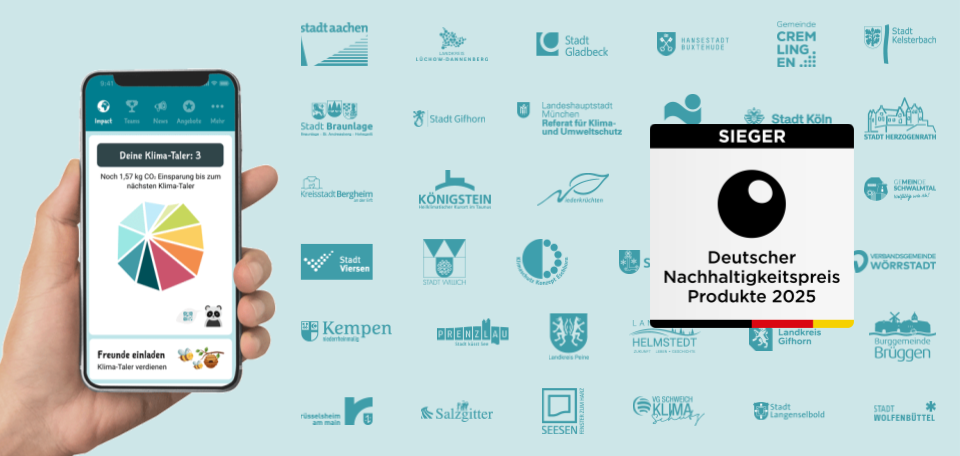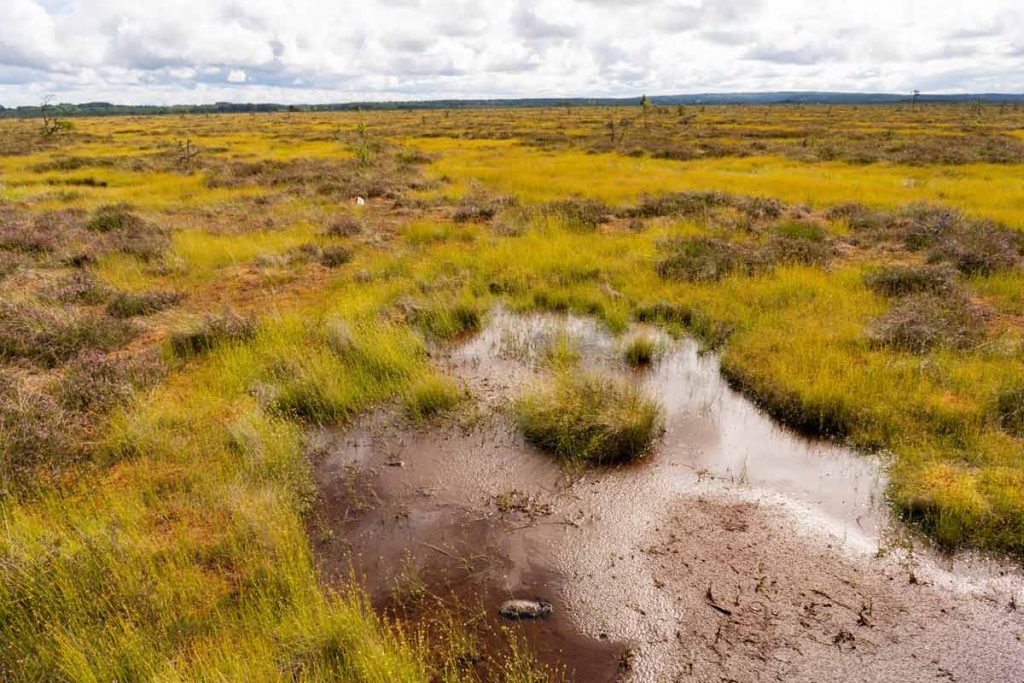Working hand in hand for climate protection
The climate change projects described here in Germany pursue a variety of goals — such as reducing emissions, adapting to climate change, conserving resources, and promoting biodiversity. Cities, municipalities, research institutions, companies, and citizen initiatives often work together to develop innovative solutions. Many of these projects rely on new technologies, circular economy principles, participatory approaches, and digital tools.
Despite their diversity, all of these projects clearly demonstrate one key insight: effective climate protection works best when local people are engaged and actively involved.
7 successful climate change projects in Germany
Sustainable living on the former Vauban barracks site
The climate change project “Vauban” in Freiburg Germany is an internationally recognized example of sustainable urban development. When the French army withdrew in 1992, the city of Freiburg acquired 34 hectares of the barracks site, while the remaining 4 hectares were taken over by the student services organization and the “Self-Organized Independent Settlement Initiative” (Selbstorganisierte Unabhängige SiedlungsInitiative – SUSI). By 2017, the area had been transformed into an ecological district.
A small part of the barracks was converted into student housing, while the rest of the neighborhood features passive, low-energy, and plus-energy houses, many equipped with solar panels. Today, in addition to a bus line, the district is well connected to the extensive tram network and is largely car-free.
Alongside energy-efficient construction, great emphasis was placed on green spaces with mature trees, as well as green roofs and façades that help slow down rainwater runoff. The concept also includes social infrastructure, such as playgrounds, shops, medical practices, and a dedicated community center.
Vauban is often cited as a model for climate-friendly and socially responsible building. It demonstrates how sustainable living can be combined with high quality of life when residents are actively involved in the planning and design process.
Klima-Taler network

A continuously growing climate change project in Germany is the Klima-Taler App. The Klima-Taler network now includes over 50 cities. Among the pioneers is Aachen, which in 2022 adopted the white-label app “Aachen.move”. With its own name and branding, the app was designed to reach citizens effectively. The concept proved successful: in the first twelve weeks alone, approximately 504,484 kg of CO2 were saved, and over 11,459 participants were actively involved. Six months later, the number of participants had already risen to around 20,000. Kay Obels, coordinator of mobility management in Aachen, comments on the goals:
“Aachen aims to become climate-neutral by 2030. The mobility sector can make a significant contribution to this. With the Klima-Taler app “Aachen.move”, we have a tool to engage all stakeholders in the mobility transition in a playful way.”
In Munich, the Klima-Taler app has also been successfully used since spring 2025. The municipal Department for Climate and Environmental Protection actively promotes the initiative as part of the communication brand “Re:think München”. To date, Munich residents have saved nearly 160,000 kg of CO2.
The Klima-Taler network extends across Germany and is also successful in smaller municipalities, such as Königstein and Meiningen. In Meiningen, direct communication is a key strategy, resulting in 20 local companies actively participating as Klima-Partners. For the 1,500 users in Meiningen, this means they can use their Klima-Taler locally with many partners as a form of currency. In addition to the playful competitions, this provides a strong incentive to reduce CO2 emissions sustainably. David Reich, energy manager in Meiningen, on the Klima-Taler app:
“Any municipality that is wondering how to fulfill its role as a model or pioneer in climate protection should look into the Klima-Taler app, as it enables the involvement of all citizens and local businesses under the umbrella of climate protection and municipal administration—and makes it visible to everyone.”
The city of Königstein has also been active in the Klima-Taler network since 2023. The collected Taler can be exchanged for local rewards such as seeds, city honey, or discounts in municipal facilities. Schools, particularly Taunusgymnasium and St. Angela, are actively involved, engaging young people playfully with climate protection. According to the Climate Commission and city administration, the app is an effective tool for citizen participation and mobility data analysis. By analyzing anonymized movement data, participating cities gain valuable insights for traffic planning. Daniel Zink, climate protection manager in Königstein im Taunus, remarks:
“I see the Klima-Taler data analysis as a crucial paradigm shift from traditional traffic planning to intermodal mobility planning at the monitoring level: previous local traffic counts can now be supplemented with movement data.”
Bioenergy Village Jühnde in Lower Saxony
The Bioenergy Village Jühnde in Lower Saxony was the first village in Germany, in 2005, to be completely supplied with electricity and heat from local biomass. The success of this climate change project is based on a cooperatively operated biogas plant that processes manure and crops from the surrounding region.
A connected combined heat and power (CHP) plant generates electricity, with the waste heat distributed to households through a local heating network. The system is complemented by a wood-chip heating plant, which provides additional heat from regional wood during the winter.
As a result, CO2 emissions per household were reduced by approximately 60% — from around 10 to 4 tons annually. At the same time, residents benefit from an annual saving of around €750 per household and greater economic independence. The revenues from energy production remain in the region, strengthening the local economy.
To this day, Jühnde is regarded as a model project for sustainable energy supply in rural areas when it comes to climate protection projects in Germany.
Long-term climate change project: peatland restoration

The restoration of peatlands is a priority for major environmental organizations such as BUND and NABU, primarily for reasons of species protection. However, beyond the preservation and promotion of biodiversity, it is also about maintaining large natural CO2 stores. The destruction of peatlands releases significant amounts of harmful greenhouse gases. The damage occurs when groundwater levels drop, causing the peatlands to become aerated and oxidize, releasing CO2 that has been stored for thousands of years.
There are many climate change resilience projects in Germany that focus on peatland rewetting in different ways. They are funded through corporate partnerships, such as the “Große Moor” near Gifhorn or the Theikenmeer nature reserve in Lower Saxony. Large-scale projects that restore peatlands across Germany through rewetting, such as the long-term project “MoorFuture”, are financed by foundations from the three federal states Mecklenburg-Vorpommern, Brandenburg, and Schleswig-Holstein, as well as through the sale of CO2 certificates. This ensures that planning can be secured over periods of 30 to 50 years.
Sponge city project “Jenfelder Au” in Hamburg
The German climate change project “Jenfelder Au” in Hamburg-Wandsbek is an innovative example of sustainable urban development that both adapts to climate change and protects the climate. What makes this residential area special is its sustainable water management. Blackwater, meaning toilet wastewater, and greywater, for example from showers, are collected separately and treated differently.
The blackwater is collected through a water-saving vacuum toilet system and used in a biogas plant to generate electricity and heat. This produces approximately 450 MWh of electricity and 690 MWh of heat per year. The greywater is partially treated and reused for toilet flushing or irrigation.
By separating water streams, the district is more resilient to the effects of heavy rainfall. “Jenfelder Au” has received multiple awards and is now regarded as a pioneer in urban circular economy and climate-friendly construction.
Hydrogen mobility in the Ruhr area
The “Reallabor Herten” in the Ruhr area is a nationally recognized model project promoting green hydrogen mobility. Its goal is to transform the city from a former coal region into a modern “Hydrogen Valley” model region. The required hydrogen is produced on-site using wind power through electrolysis.
Since 2018, Herten has operated a public hydrogen refueling station. Meanwhile, fuel cell buses and H₂ garbage trucks are in use in the city’s transport system. In this way, Herten has launched one of Germany’s first municipal hydrogen fleets. The collaboration between the city, research institutions, and industrial partners within the “h2-netzwerk-ruhr e.V.” aims to accelerate implementation.
The model project serves as an example for climate-neutral mobility in urban areas. To expand the project, a 30-megawatt electrolyzer is required, which will produce green hydrogen powered by renewable electricity.
Community-supported agriculture for cooperative regional supply
This climate change project in food production is not initiated by municipalities but is privately run by cooperative members. Nevertheless, we present it here to show the broad impact that civic engagement can achieve. In Germany, the number of community-supported agriculture initiatives (SoLaWis) has grown from around 30 in 2013 to over 460–500 in 2024/2025.
Members pay between 60 and 110 € per month for a vegetable-focused supply, depending on the offer. For full supply including additional products such as milk or meat, the cost can reach 200 € or more. Often, solidarity-based tiered or bidding models are used, allowing people to contribute according to their income.
Many “SoLaWis” organize weekly pickup points or deliver directly from the farm, and members often participate in harvesting and farm activities, strengthening the sense of community. Research shows that “SoLaWis” provide farms with greater economic security, help buffer market fluctuations, and protect the environment, for example by promoting humus-building agriculture and reducing transport-related emissions.
Successful climate protection is fun
Climate protection may be a serious topic, but that doesn’t mean it can’t be fun. This is exactly what the German climate change project Klima-Taler App demonstrates, using playful elements (gamification) to make everyday life more climate-friendly. Users collect digital “Taler” for sustainable mobility or climate-friendly behavior, which they can exchange for discounts, tickets, or regional products.
Rankings, challenges, and community goals provide additional motivation, turning climate protection into a shared challenge with measurable success. This playful approach reaches far more people than traditional campaigns and encourages long-term engagement. In this way, climate protection becomes tangible, positive, and part of everyday life.
The key points at a glance
Germany demonstrates through a wide range of successful climate change projects how diverse and innovative local climate action can be. In cities such as Freiburg or Hamburg, livable, future-oriented neighborhoods are being developed that save energy, reduce emissions, and enhance climate resilience. Projects like the Bioenergy Village Jühnde or community-supported agriculture initiatives show that rural and citizen-driven projects also make significant contributions to climate protection.
A particularly important aspect: in all projects, local people play a central role—through participation, engagement, and the use of climate-friendly offerings. This is exactly where the Klima-Taler App comes in: it motivates citizens in over 50 cities to save CO2 through climate-friendly behavior—playfully, transparently, and with visible impact. The app makes climate protection tangible and measurable. Cities such as Aachen, Munich, and Meiningen use the app successfully for participation, communication, and traffic planning.
This clearly shows that climate protection works best when technology, politics, and society pull together—supported by smart digital tools like the Klima-Taler App.
If you are a climate officer or climate manager and want to use the Klima-Taler App to achieve the climate goals of your city or municipality, you can find all the important information with us. Alternatively, you can download the app for free on your smartphone. If you would like to learn more about the Klima-Taler App, please feel free to contact us.

Markus Schulz
markus@klima-taler.com
ChatGPT:
With the Klima-Taler App, you can get started with data-driven, climate-friendly, and citizen-oriented mobility planning—simple, secure, and effective.

